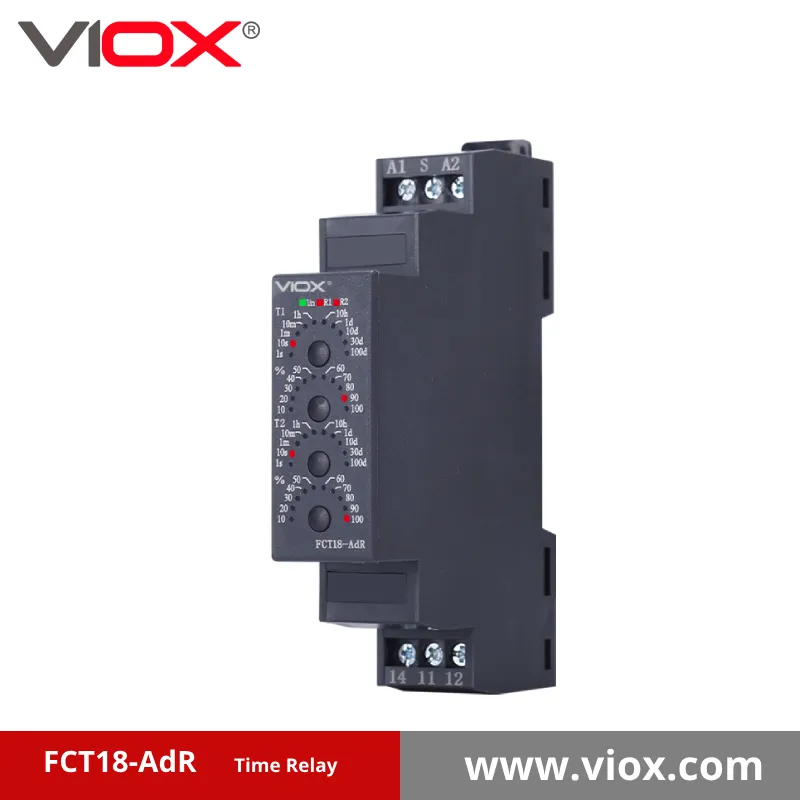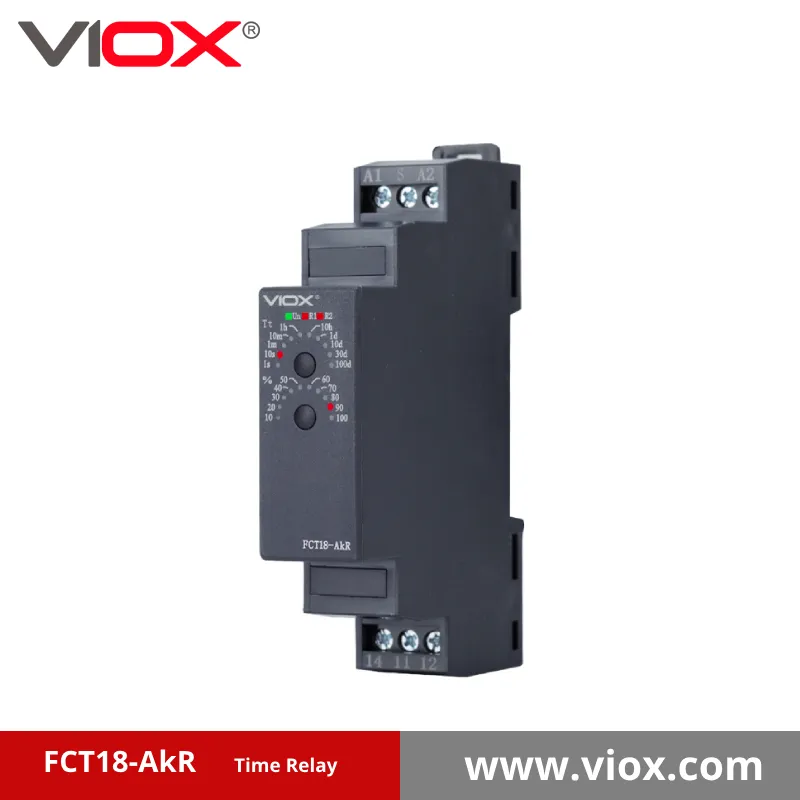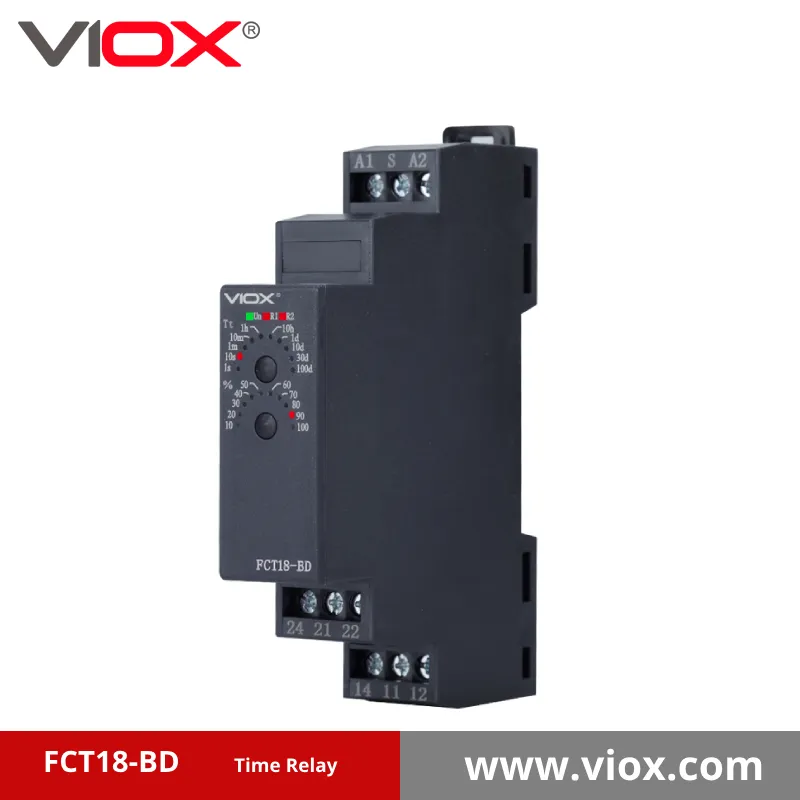The main difference between SPDT and DPDT time relays is their switching capacity: SPDT (Single Pole Double Throw) controls one circuit with two possible positions, while DPDT (Double Pole Double Throw) controls two separate circuits simultaneously with four possible switching combinations. Understanding this distinction is crucial for selecting the right time relay for your electrical control applications.
What Are SPDT and DPDT Time Relays?
SPDT Time Relay Definition
A Single Pole Double Throw (SPDT) time relay is a timing control device that switches a single electrical circuit between two different output terminals after a predetermined time delay. The “single pole” means it controls one circuit path, while “double throw” indicates it can connect to either of two output positions.
Klíčové vlastnosti:
- Controls one circuit at a time
- Three terminals: Common (C), Normally Open (NO), and Normally Closed (NC)
- Switches between two states based on timing function
- Simpler wiring and control logic
DPDT Time Relay Definition
A Double Pole Double Throw (DPDT) time relay is a timing control device that simultaneously switches two separate electrical circuits, each between two different output terminals, after a predetermined time delay. This configuration essentially provides two SPDT switches operating together.
Klíčové vlastnosti:
- Controls two independent circuits simultaneously
- Six terminals: Two sets of Common (C1, C2), Normally Open (NO1, NO2), and Normally Closed (NC1, NC2)
- Provides complete electrical isolation between circuits
- More complex control capabilities
SPDT vs DPDT Time Relay Comparison Table
| Funkce | SPDT Time Relay | DPDT Time Relay |
|---|---|---|
| Number of Circuits Controlled | 1 obvod | 2 independent circuits |
| Terminal Count | 3 terminals (C, NO, NC) | 6 terminals (C1, NO1, NC1, C2, NO2, NC2) |
| Switching Positions | 2 positions | 4 switching combinations |
| Elektrická izolace | Single circuit | Complete isolation between circuits |
| Typical Voltage Rating | 120V-480V AC/DC | 120V-480V AC/DC |
| Současná kapacita | 5A-30A per pole | 5A-30A per pole (both poles) |
| Náklady | Spodní | Vyšší |
| Složitost instalace | Jednoduchý | More complex |
| Panel Space Required | Less | More |
| Běžné aplikace | Basic on/off control, simple switching | Motor reversing, dual circuit control |
Key Differences Between SPDT and DPDT Time Relays
1. Circuit Control Capacity
SPDT Configuration:
- Manages one electrical path
- Switches between normally open and normally closed positions
- Ideal for basic timing applications
DPDT Configuration:
- Manages two independent electrical paths
- Each pole operates like an individual SPDT switch
- Enables complex control scenarios
2. Terminal Configuration
SPDT Terminal Layout:
- Common (C): Input connection point
- Normálně otevřený (NO): Connects when relay energizes
- Normálně zavřený (NC): Disconnects when relay energizes
DPDT Terminal Layout:
- Pole 1: C1, NO1, NC1
- Pole 2: C2, NO2, NC2
- Both poles switch simultaneously
3. Safety Considerations
⚠️ Bezpečnostní upozornění: Always de-energize circuits before making connections. Follow NEC Article 430 for motor control applications and ensure proper electrical isolation.
SPDT Safety Features:
- Single point of failure
- Simpler troubleshooting
- Reduced connection errors
DPDT Safety Features:
- True electrical isolation between circuits
- Redundant switching capability
- Enhanced safety for critical applications
Aplikace a případy použití
SPDT Time Relay Applications
Common Industrial Uses:
- Basic motor starting delays
- Systémy řízení osvětlení
- HVAC fan delay circuits
- Simple on/off timing functions
- Pump control applications
Specific Example: A cooling fan that starts 30 seconds after a motor begins operation, providing adequate warm-up time.
DPDT Time Relay Applications
Advanced Control Applications:
- Motor direction reversing circuits
- Dual heating/cooling control
- Emergency backup system switching
- Multi-zone HVAC control
- Process control with feedback loops
Specific Example: A conveyor system requiring forward/reverse operation with timing delays for direction changes.
Selection Criteria: How to Choose the Right Time Relay
Choose SPDT When:
- Simple switching requirements with one circuit
- Rozpočtová omezení are a primary concern
- Panel space is limited
- Basic timing functions are sufficient
- Troubleshooting simplicity is important
Choose DPDT When:
- Více obvodů need simultaneous control
- Elektrická izolace between circuits is required
- Motor reversing applications are needed
- Backup or redundant switching is necessary
- Complex control logic requires dual switching
Installation and Wiring Guidelines
SPDT Wiring Best Practices
- Identify terminals correctly: C (Common), NO (Normally Open), NC (Normally Closed)
- Connect control voltage to relay coil terminals
- Wire load circuit through appropriate NO or NC contacts
- Use proper gauge wire based on current rating
- Install appropriate fusing dle požadavků NEC
DPDT Wiring Best Practices
- Label both poles clearly (Pole 1, Pole 2)
- Maintain circuit separation for safety
- Use appropriate contactors for high-current applications
- Implement proper grounding for each circuit
- Consider arc suppression for inductive loads
Expert Tips for Time Relay Selection
💡 Professional Recommendation: Always select relays with 25% higher current rating than your actual load requirement to ensure reliable long-term operation.
Performance Optimization Tips
- Consider ambient temperature effects on timing accuracy
- Use auxiliary contacts for feedback indication
- Implement proper shielding in high-noise environments
- Plan for easy maintenance access
- Document wiring clearly for future service
Časté chyby při výběru, kterým je třeba se vyhnout
- Podcenění současných požadavků
- Ignoring environmental conditions
- Overlooking timing accuracy needs
- Failing to consider expansion requirements
- Neglecting proper protection devices
Řešení běžných problémů
SPDT Relay Problems
Příznak: Relay doesn’t switch
- Check coil voltage and continuity
- Verify contact condition and cleanliness
- Test timing circuit functionality
Příznak: Contacts burn prematurely
- Reduce inrush current with soft starters
- Add arc suppression for inductive loads
- Check for proper current rating
DPDT Relay Problems
Příznak: Only one pole operating
- Test each pole independently
- Check for mechanical binding
- Verify individual contact integrity
Příznak: Timing inconsistency
- Check power supply stability
- Verify ambient temperature effects
- Test timing circuit components
Dodržování předpisů a standardů
Relevant Electrical Codes
- Článek 430 NEC: Motor control applications
- NEMA ICS Standards: Industrial control equipment
- UL 508A: Průmyslové ovládací panely
- IEC 61810: Electromechanical elementary relays
Požadavky na instalaci
- Dodržujte údaje výrobce o krouticím momentu
- Maintain proper spacing for heat dissipation
- Use appropriate enclosure ratings (NEMA 1, 4, 12)
- Implement proper overcurrent protection
Úvahy o nákladech a návratnosti investic
Porovnání počátečních investic
SPDT Cost Factors:
- Lower equipment cost
- Zkrácená doba instalace
- Simpler troubleshooting
- Lower inventory requirements
DPDT Cost Factors:
- Higher equipment cost
- Increased installation complexity
- More comprehensive functionality
- Greater long-term flexibility
Long-term Value Analysis
DPDT relays often provide better long-term value for complex applications despite higher initial costs due to:
- Reduced need for multiple components
- Enhanced control capabilities
- Zvýšená spolehlivost systému
- Future expansion flexibility
Často Kladené Otázky
What is the main advantage of DPDT over SPDT time relays?
DPDT time relays provide complete electrical isolation between two independent circuits while offering simultaneous switching control, making them ideal for motor reversing and dual circuit applications where SPDT relays cannot provide adequate functionality.
Can I use a DPDT relay in place of an SPDT relay?
Yes, you can use a DPDT relay to replace an SPDT relay by utilizing only one pole of the DPDT configuration. However, this approach increases cost without providing additional functionality benefits.
How do I determine the correct current rating for my time relay?
Calculate your actual load current and select a relay with at least 25% higher current rating. For motor applications, consider starting current (typically 6-8 times running current) and consult NEC Article 430 for specific requirements.
What timing accuracy can I expect from modern time relays?
Modern electronic time relays typically provide timing accuracy of ±1% to ±5% depending on the model and environmental conditions. For critical applications requiring higher precision, consider programmable timing controllers.
Are there safety differences between SPDT and DPDT configurations?
DPDT relays provide enhanced safety through complete electrical isolation between circuits and redundant switching capability. For critical safety applications, DPDT configuration offers superior fault tolerance and control flexibility.
How often should time relays be tested or replaced?
Test time relays annually in critical applications and every 2-3 years in standard applications. Replace immediately if timing accuracy degrades beyond acceptable limits or contact resistance increases significantly.
Can time relays operate in outdoor environments?
Yes, but ensure proper NEMA-rated enclosures (NEMA 4 or 4X for outdoor use) and consider temperature effects on timing accuracy. Some relays require derating in extreme temperature conditions.
What’s the difference between mechanical and electronic time relays?
Electronic time relays offer superior timing accuracy, longer life, and resistance to vibration, while mechanical relays provide lower cost and simpler operation. Electronic types are preferred for most modern applications.
Závěr: Udělat správnou volbu
For basic timing applications with single circuit control requirements, SPDT time relays provide cost-effective, reliable operation with simple installation and maintenance.
For complex applications requiring dual circuit control, motor reversing, or electrical isolation between circuits, DPDT time relays deliver superior functionality and long-term value despite higher initial investment.
When selecting between SPDT and DPDT time relays, prioritize your specific application requirements, safety considerations, and future expansion needs. Always consult with qualified electricians for critical applications and ensure compliance with local electrical codes.
Profesionální doporučení: For new installations, consider DPDT relays even for single-circuit applications if budget allows, as they provide greater flexibility for future modifications and enhanced troubleshooting capabilities.








